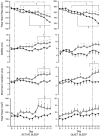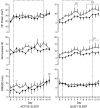Altered autonomic control of heart rate variability in the chronically hypoxic fetus
- PMID: 29604064
- PMCID: PMC6265555
- DOI: 10.1113/JP275659
Altered autonomic control of heart rate variability in the chronically hypoxic fetus
Abstract
Key points: Fetal heart rate variability (FHRV) has long been recognised as a powerful predictor of fetal wellbeing, and a decrease in FHRV is associated with fetal compromise. However, the mechanisms by which FHRV is reduced in the chronically hypoxic fetus have yet to be established. The sympathetic and parasympathetic influences on heart rate mature at different rates throughout fetal life, and can be assessed by time domain and power spectral analysis of FHRV. In this study of chronically instrumented fetal sheep in late gestation, we analysed FHRV daily over a 16 day period towards term, and compared changes between fetuses of control and chronically hypoxic pregnancy. We show that FHRV in sheep is reduced by chronic hypoxia, predominantly due to dysregulation of the sympathetic control of the fetal heart rate. This presents a potential mechanism by which a reduction in indices of FHRV predicts fetuses at increased risk of neonatal morbidity and mortality in humans. Reduction in overall FHRV may therefore provide a biomarker that autonomic dysregulation of fetal heart rate control has taken place in a fetus where uteroplacental dysfunction is suspected.
Abstract: Although fetal heart rate variability (FHRV) has long been recognised as a powerful predictor of fetal wellbeing, the mechanisms by which it is reduced in the chronically hypoxic fetus have yet to be established. In particular, the physiological mechanism underlying the reduction of short term variation (STV) in fetal compromise remains unclear. In this study, we present a longitudinal study of the development of autonomic control of FHRV, assessed by indirect indices, time domain and power spectral analysis, in normoxic and chronically hypoxic, chronically catheterised, singleton fetal sheep over the last third of gestation. We used isobaric chambers able to maintain pregnant sheep for prolonged periods in hypoxic conditions (stable fetal femoral arterial 10-12 mmHg), and a customised wireless data acquisition system to record beat-to-beat variation in the fetal heart rate. We determined in vivo longitudinal changes in overall FHRV and the sympathetic and parasympathetic contribution to FHRV in hypoxic (n = 6) and normoxic (n = 6) ovine fetuses with advancing gestational age. Normoxic fetuses show gestational age-related increases in overall indices of FHRV, and in the sympathetic nervous system contribution to FHRV (P < 0.001). Conversely, gestational age-related increases in overall FHRV were impaired by exposure to chronic hypoxia, and there was evidence of suppression of the sympathetic nervous system control of FHRV after 72 h of exposure to hypoxia (P < 0.001). This demonstrates that exposure to late gestation isolated chronic fetal hypoxia has the potential to alter the development of the autonomic nervous system control of FHRV in sheep. This presents a potential mechanism by which a reduction in indices of FHRV in human fetuses affected by uteroplacental dysfunction can predict fetuses at increased risk.
Keywords: Fetal Growth Restriction; Fetal heart rate; Fetal heart rate variability; Intrauterine hypoxia; Sympathetic nervous system.
© 2018 The Authors. The Journal of Physiology published by John Wiley & Sons Ltd on behalf of The Physiological Society.
Figures







Comment in
-
No sympathy for the hypoxic: the role of fetal oxygenation in autonomic dysfunction.J Physiol. 2018 Dec;596(23):5507-5508. doi: 10.1113/JP276227. Epub 2018 Jun 8. J Physiol. 2018. PMID: 29774552 Free PMC article. No abstract available.
Similar articles
-
First evidence that intrinsic fetal heart rate variability exists and is affected by hypoxic pregnancy.J Physiol. 2020 Jan;598(2):249-263. doi: 10.1113/JP278773. Epub 2020 Jan 9. J Physiol. 2020. PMID: 31802494
-
Parasympathetic activity is the key regulator of heart rate variability between decelerations during brief repeated umbilical cord occlusions in fetal sheep.Am J Physiol Regul Integr Comp Physiol. 2020 Nov 1;319(5):R541-R550. doi: 10.1152/ajpregu.00186.2020. Epub 2020 Sep 2. Am J Physiol Regul Integr Comp Physiol. 2020. PMID: 32877241
-
Evolving changes in fetal heart rate variability and brain injury after hypoxia-ischaemia in preterm fetal sheep.J Physiol. 2018 Dec;596(23):6093-6104. doi: 10.1113/JP275434. Epub 2018 Jan 30. J Physiol. 2018. PMID: 29315570 Free PMC article.
-
Physiological control of fetal heart rate variability during labour: implications and controversies.J Physiol. 2022 Feb;600(3):431-450. doi: 10.1113/JP282276. Epub 2022 Jan 17. J Physiol. 2022. PMID: 34951476 Review.
-
Power spectral analysis of fetal heart rate.Baillieres Clin Obstet Gynaecol. 1994 Sep;8(3):643-61. doi: 10.1016/s0950-3552(05)80203-2. Baillieres Clin Obstet Gynaecol. 1994. PMID: 7813133 Review.
Cited by
-
Growth-restricted human fetuses have preserved respiratory sinus arrhythmia but reduced heart rate variability estimates of vagal activity during quiescence.Physiol Rep. 2022 Nov;10(22):e15458. doi: 10.14814/phy2.15458. Physiol Rep. 2022. PMID: 36411966 Free PMC article.
-
Fetal heart rate variability is a biomarker of rapid but not progressive exacerbation of inflammation in preterm fetal sheep.Sci Rep. 2022 Feb 2;12(1):1771. doi: 10.1038/s41598-022-05799-3. Sci Rep. 2022. PMID: 35110628 Free PMC article.
-
Breath of Life: Heart Disease Link to Developmental Hypoxia.Circulation. 2021 Oct 26;144(17):1429-1443. doi: 10.1161/CIRCULATIONAHA.121.054689. Epub 2021 Oct 25. Circulation. 2021. PMID: 34694887 Free PMC article.
-
Antioxidants: powering the fight against fetal hypoxia.Philos Trans R Soc Lond B Biol Sci. 2025 Aug 21;380(1933):20240183. doi: 10.1098/rstb.2024.0183. Epub 2025 Aug 21. Philos Trans R Soc Lond B Biol Sci. 2025. PMID: 40836816 Free PMC article. Review.
-
Marked variability in intrapartum electronic fetal heart rate patterns: association with neonatal morbidity and abnormal arterial cord gas.J Perinatol. 2020 Jan;40(1):56-62. doi: 10.1038/s41372-019-0520-9. Epub 2019 Oct 2. J Perinatol. 2020. PMID: 31578422 Free PMC article.
References
-
- Assali NS, Brinkman CR 3rd, Woods JR Jr, Dandavino A & Nuwayhid B (1977). Development of neurohumoral control of fetal, neonatal, and adult cardiovascular functions. Am J Obstet Gynecol 129, 748–759. - PubMed
-
- Bennet L & Gunn AJ (2009). The fetal heart rate response to hypoxia: insights from animal models. Clin Perinatol 36, 655–672. - PubMed
Publication types
MeSH terms
Grants and funding
LinkOut - more resources
Full Text Sources
Other Literature Sources

